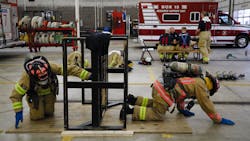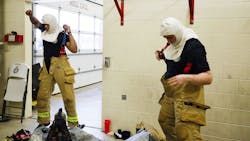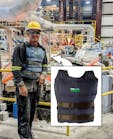OH Firefighter Recruits Try Out New Gear to Reduce Cancer
By Maeve Walsh
Source The Columbus Dispatch, Ohio
With 50 pounds of gear, body-tight layers that can reach up to 100 degrees and clunky oxygen tanks on their backs, firefighters in training dragged themselves blindfolded through a claustrophobia-inducing 18-inch by 18-inch hole in a wall.
Once they made it through, Columbus Division of Fire Capt. Ryan Brzezinski removed their oxygen tanks — forcing them to go without air for 10 seconds before putting the tanks back on.
"If you're the guy with that mask on, then that 10 seconds feels like 10 minutes," he said.
The "American Ninja Warrior"-esque simulation Friday morning at the Columbus Fire Training Academy was part of a three-day training for city fire recruits, helping them get acclimated to new fire gear.
The new gear is specifically designed to reduce firefighters' exposure to carcinogens and other contaminants while on the job, Battalion Chief Steve Martin said.
As reported by The Dispatch in its award-winning series "Unmasked," firefighters are at least 14% more likely to be diagnosed with cancer than other individuals.
"Our intent is to prevent poisonous particulates of smoke from getting into pores, and then into the bloodstream," Lt. Michael Bishop said.
Along with crawling through tight spaces, recruits repeatedly practiced putting on all 50 pounds of gear, both in an out of a fire truck, as quickly as possible.
Capt. Mark Mattox said the state of Ohio requires recruits to master getting dressed in under two minutes, but the Columbus division holds a stricter standard of 90 seconds.
Time is of the essence when getting dressed, he said, because even a few seconds delay in responding to a fire can lead to fatalities.
Bishop said both the old and new gear have three layers: the coat outer layer that helps protects from water, cold and prevents rips and tears; the middle layer or "vapor barrier" to protect from water or toxic liquids; and the inner layer or "thermal barrier" to protect from heat in the room.
The updated gear maintains these layers but also incorporates an interior skirt to cover the midsection, with a tight elastic band near the waist to restrict particles from moving up the gear.
The wrist cuffs in the new gear have an added vapor barrier to better prevent toxic material from entering via the sleeve, and the gloves are composed of sturdier material to protect firefighters' hands from injury.
Coat zippers were also added, replacing the traditional buckles, to serve as an air-tight seal while also allowing firefighters to get dressed faster.
Martin said the new gear is slightly warmer than the old gear, which can cause heat stress and other health problems. Designing firefighting gear is difficult, he said, because both the intake of contaminants and the intake of heat have to be considered.
Steve Stein, president of the Columbus Firefighters Union, said the updated gear is a step in the right direction to keeping firefighters safe.
Although the gear went through a series of tests by the National Fire Protection Association, Stein said it's hard to determine whether gear is actually effective in reducing cancer and other disease.
"It's so hard to look at our population in terms of efficacy of initiatives because you don't know when or if someone has cancer because it's dormant," he said. "We have to look at these numbers in retrospect."
Martin said fire divisions across the country have come a long way in recent years in regards to acknowledging the risk of cancer and disease among firefighters, largely because of the lack of awareness surrounding the risks.
A "macho man" culture among firefighters also contributed to rates of illness, Martin said. He said he and his fellow firefighters would return to the station from a scene covered in smoke and bee-line right for the fridge — without taking off their gear or jumping in the shower.
"It used to be a badge of honor to have soot everywhere," he said. "Like, 'Wow, that guy was really doing it.'"
Now, the Columbus division takes several precautions, in addition to updated gear, to combat the rates of disease, Martin said.
Firefighters are required to remove their gear at the scene after putting out a fire, and the gear is sent to industrial washers to completely rid of contaminants, he said.
The division also employs a "first in, first out" rule, where groups of firefighters take shifts at the scene of a fire to limit the amount of toxins one group is exposed to.
Two new fire stations — Station 35 nearing completion at 711 N. Waggoner Road on the Far East Side and replacement Station 16 under construction since last September at 1465 Oakland Park Ave. in Linden — will have special decontamination areas for firefighters to remove their gear, Martin said.
Stein commended the city for working to ensure "that we have the best gear and resources available to take care of the citizens in Columbus."
———
©2020 The Columbus Dispatch (Columbus, Ohio)
Visit The Columbus Dispatch (Columbus, Ohio) at www.dispatch.com
Distributed by Tribune Content Agency, LLC.








